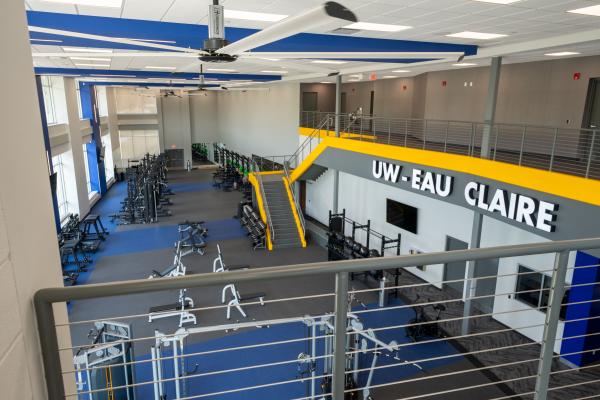"Ensuring this building is not only great when it opens but continues to be used as an impressive space for future students, faculty, staff and community members to enjoy just shows the dedication to making sure this building is impacting not only students this academic year, but far into the future," Consiglio says.
The $122 million complex built on a redeveloped brownfield site has 190 vertical geothermal wells using 36 miles of piping to heat and cool the building. The building is fully electric with Xcel Energy providing power from a local, off-site solar facility.
Other sustainability features include LED lighting throughout the facility; green vehicle parking and electric vehicle charging stations; heavy use of native plantings and nonirrigated landscape; and removal of 80% of total suspended solids from storm water runoff.
Community partners helped make the sustainability features possible in the state-of-the-art building. Pablo Foundation and city of Eau Claire made significant financial investments, and building designer Ayres Associates, primary contractor Market & Johnson and Xcel Energy all played significant roles in the sustainability features in the project, Way says.
“We always benefit when we collaborate with partners who have a shared vision that will positively impact all of us,” Way says. “We are deeply grateful for all our partners.”
Pablo Foundation provided nearly $10 million toward the sustainability efforts in the complex, including money toward the geothermal wells. MaiVue Xiong, executive director of Pablo Foundation, says the foundation is committed to working toward an environmentally sustainable community for generations to come and The Sonnentag project was an opportunity to help design a carbon-neutral facility that could become a standard for future buildings.
“Obtaining gold LEED certification for such a prominent building that will bring together so many people signifies the university’s and all our partners’ commitment to the environment and our community,” Xiong says. “We are grateful for everyone’s efforts in making this certification a reality in our community because it will make Eau Claire an even more exciting place to live, work and grow up in.”
Students of Dr. James Boulter, professor and chair of the public health and environmental studies department, toured The Sonnentag during construction to examine sustainability features and he hopes to continue the practice now that the complex is open. Boulter says the gold LEED certification is “beyond my wildest dreams,” especially because the building is an athletic complex with massively large, enclosed spaces.
“I think it sends a really clear message that buildings of this scale, size and ambition can be made and operated sustainably, and that it can be done by a university,” Boulter says. “It sends a message to the Eau Claire community, but also to the higher education community and, just as importantly, to the sports infrastructure community, that you can build these advanced and sustainable operational sporting event venues.”
The Sonnentag sustainability features include:
- Redevelopment of brownfield site.
- A total of 190 vertical geothermal wells using 36 miles of piping to heat and cool the building.
- Building is fully electric and will not consume fossil fuels, reducing carbon emissions with a local, off-site solar facility.
- Improved building performance achieved with greater insulation, energy-efficient wall systems, and high-performance window and door systems.
- Building automation system provides high level of electrical and mechanical building system control, tracks performance to adjust and improve over time.
- LED lighting throughout the facility.
- Green vehicle parking, electric vehicle charging stations.
- Heavy use of native plantings and nonirrigated landscape.
- Removal of 80% of total suspended solids from storm water runoff.
- LEED certification, WELL rating achieved.





